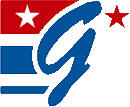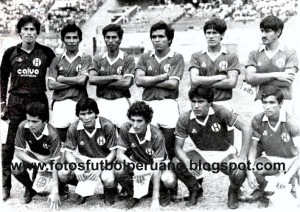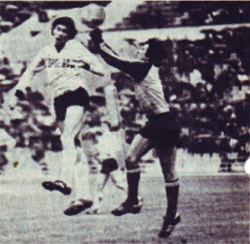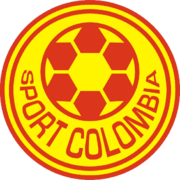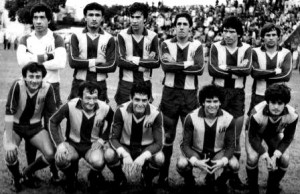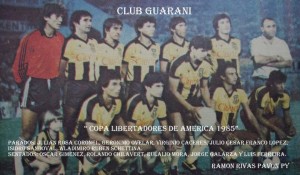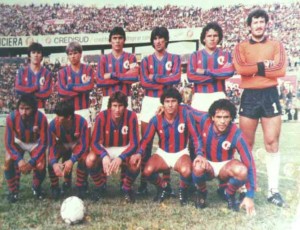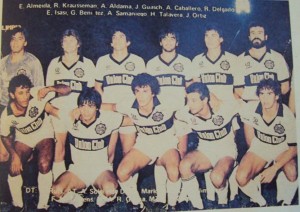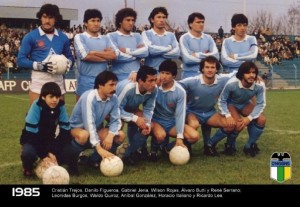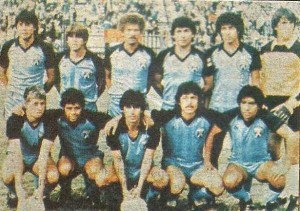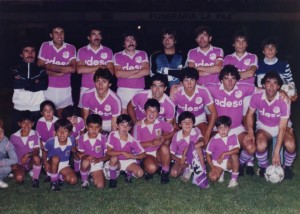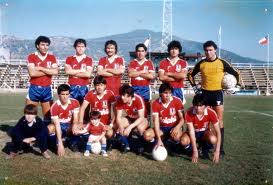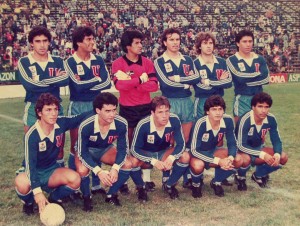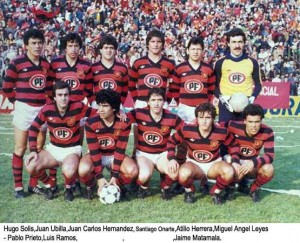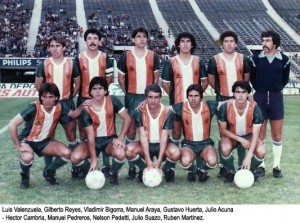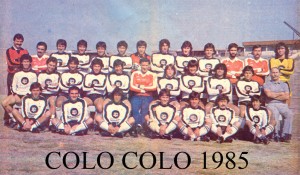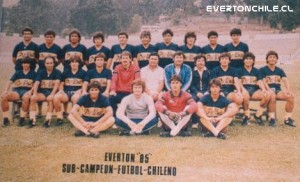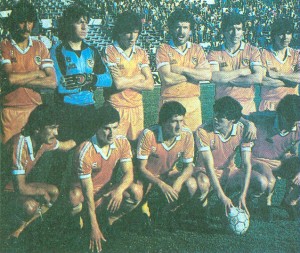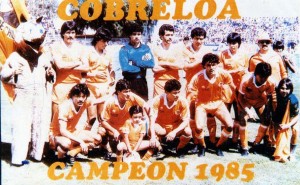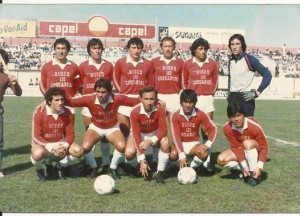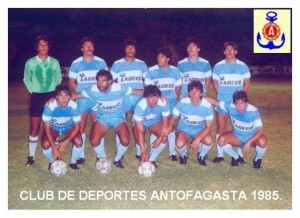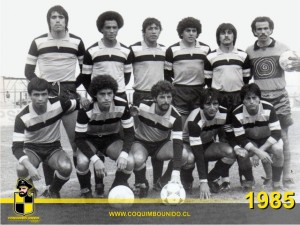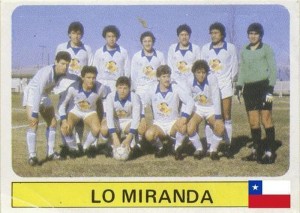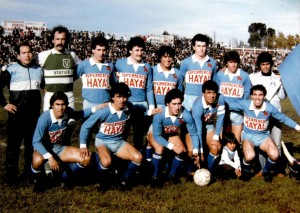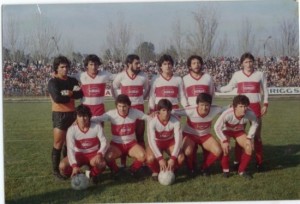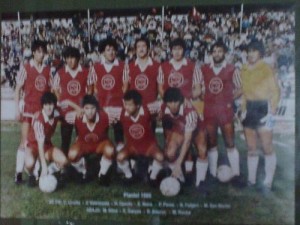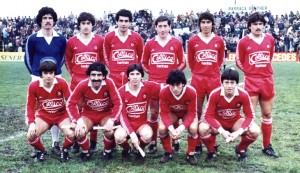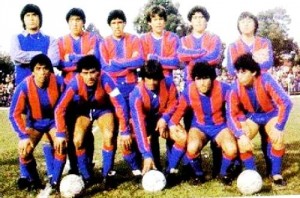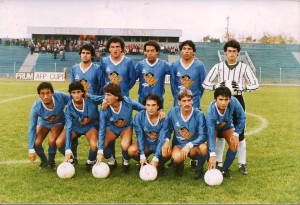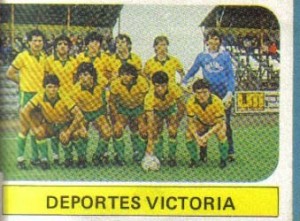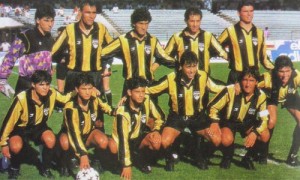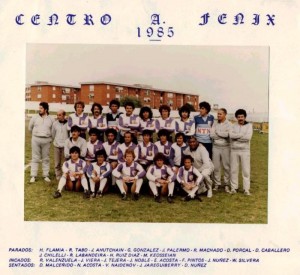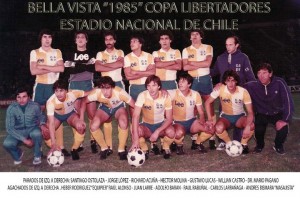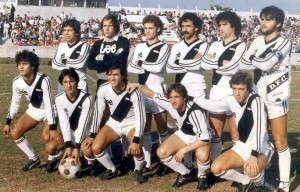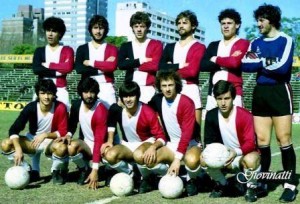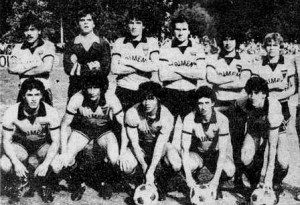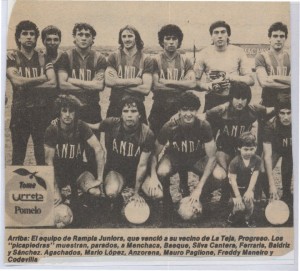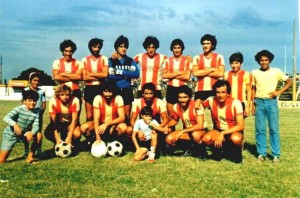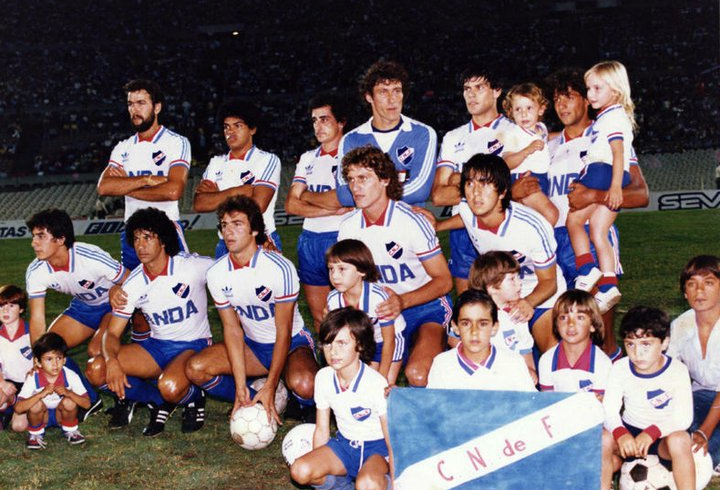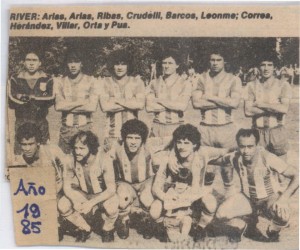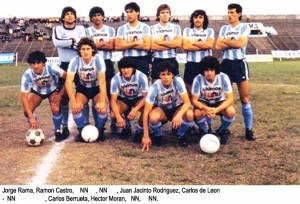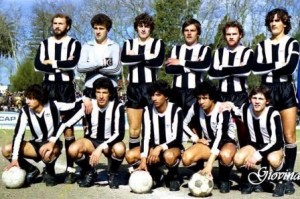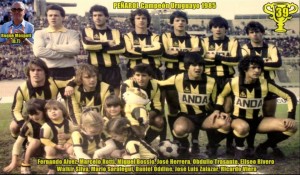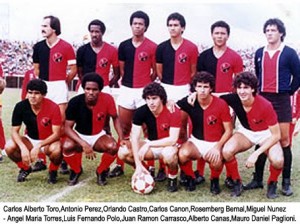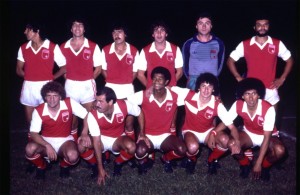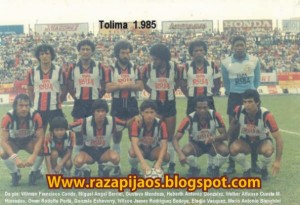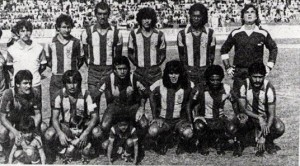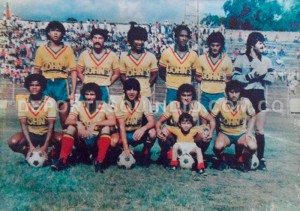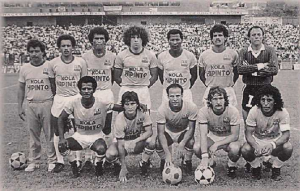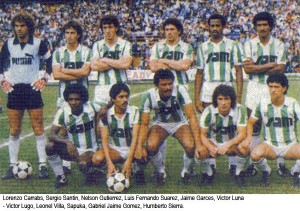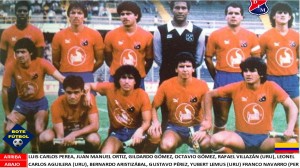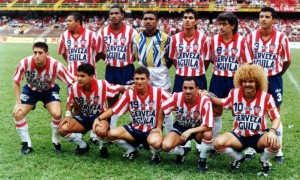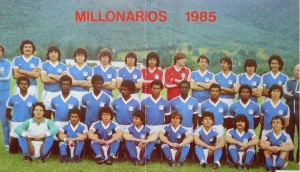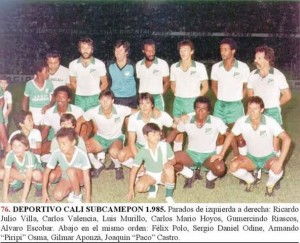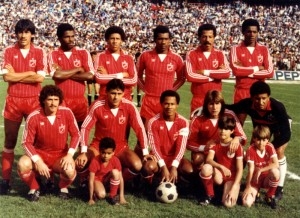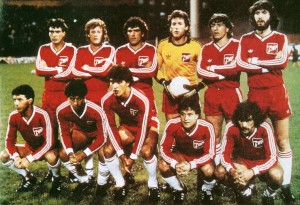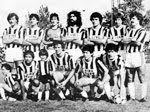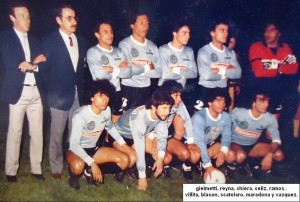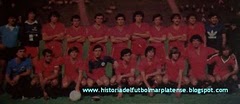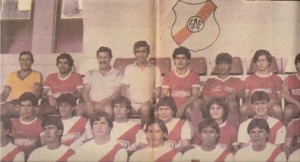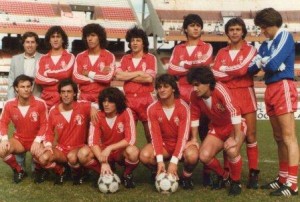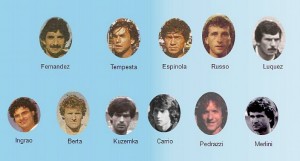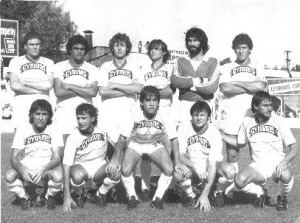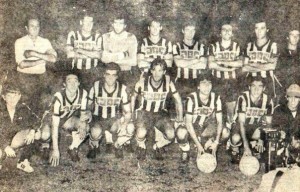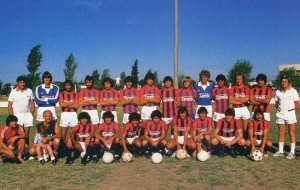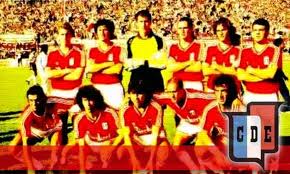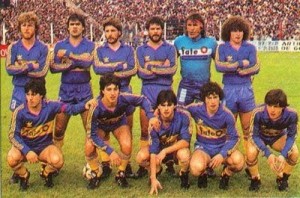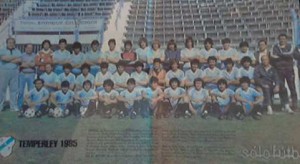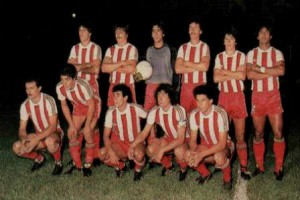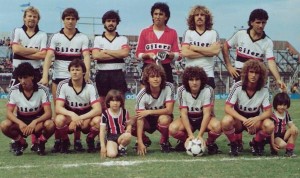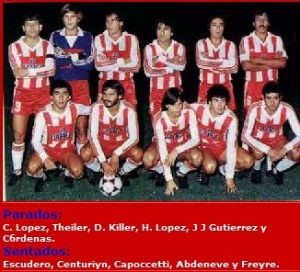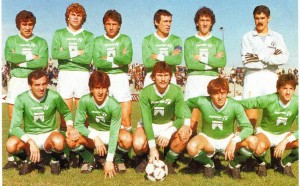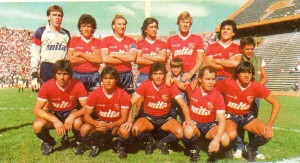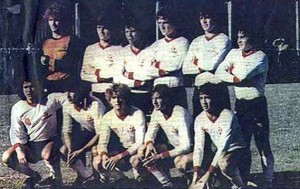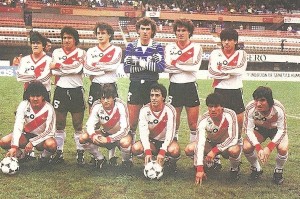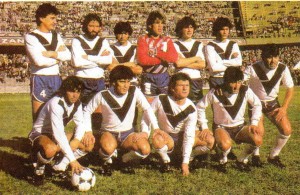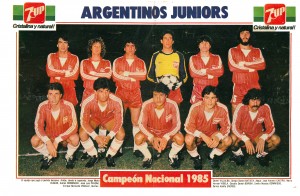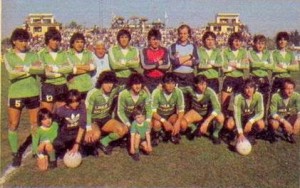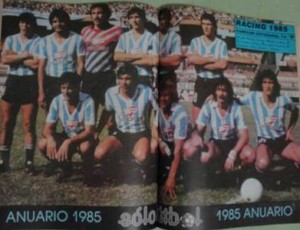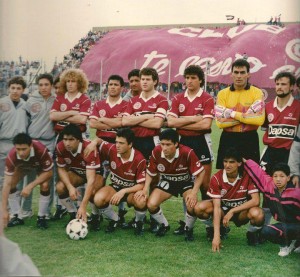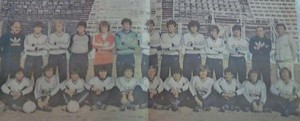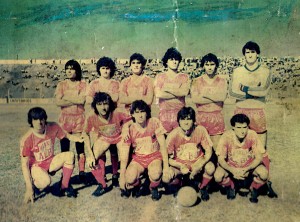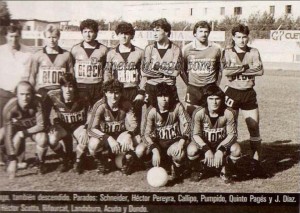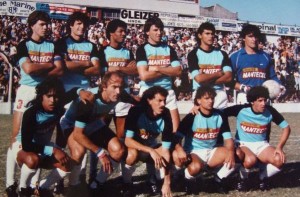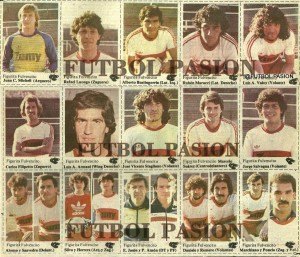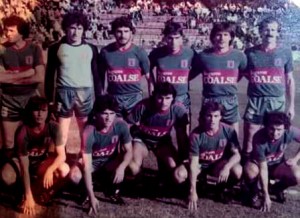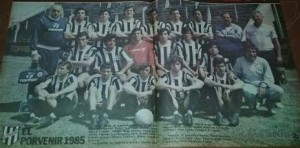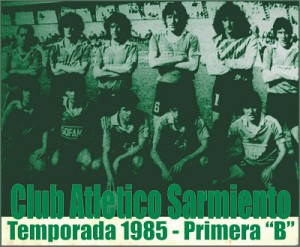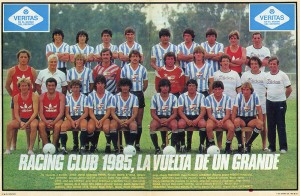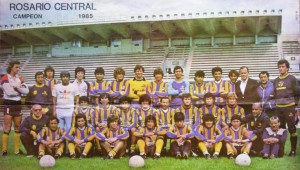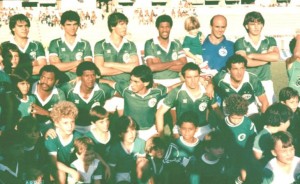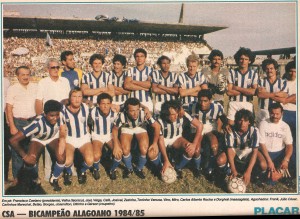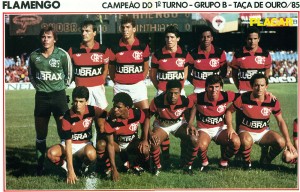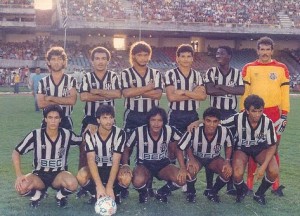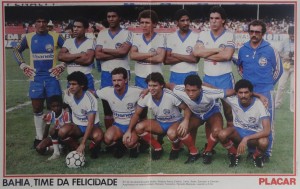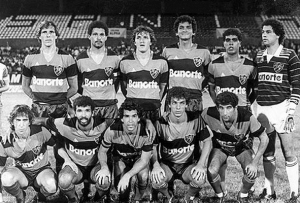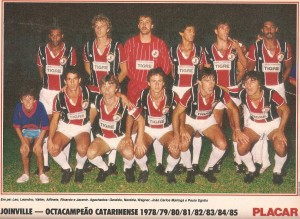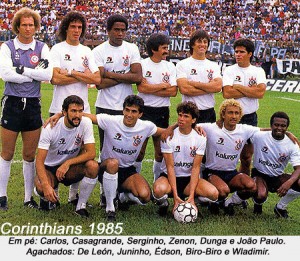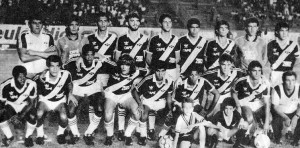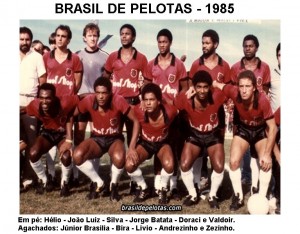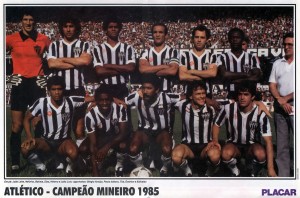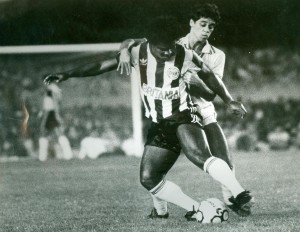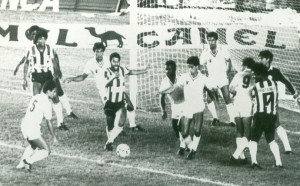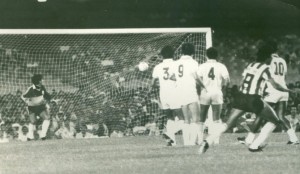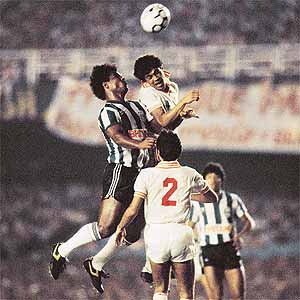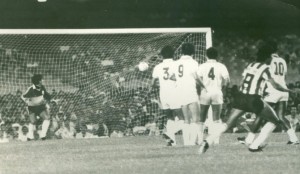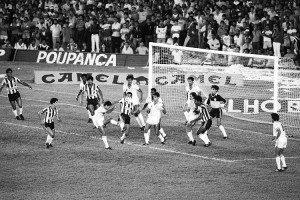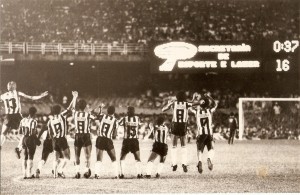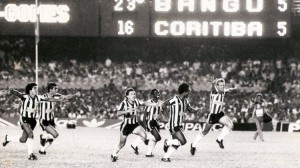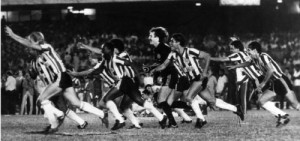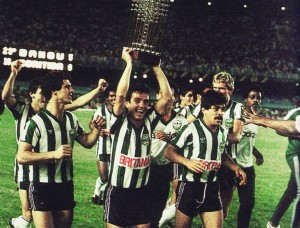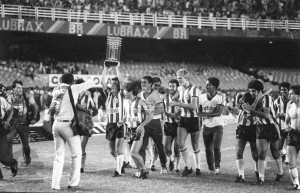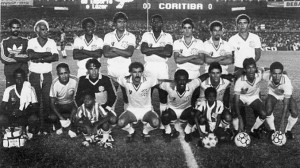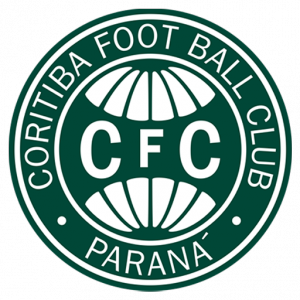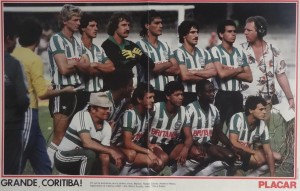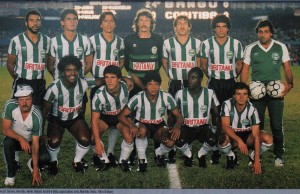Taca de Ouro -the national championship of Brazil, the top level. 44 teams. 20 chosen by historical record – that made sure no ‘big’ club was left out, no matter in what shape they currently were. Two teams promoted from 1984 second level – that was fair. 22 teams chosen by their 1984 state championships standing. One assumes, those teams were the reigning champions of their respective states. Assumptions are safe way to deal with byzantine Brazilian ways – investigations are more difficult. The championship had simplified structure this year: at first, the participants were divided into 4 groups – the 20 ‘historic’ clubs were in Group A and Group B, 10 teams each. The rest were in Group C and Group D, 12 teams each. The groups played only against each other – twice, with separate fianl table after each phase. No team played against any of the teams belonging to its own group. Confusing? Just wait… After the first round ended, there was a final table and the winners of each group qualified to the next stage. Then the second round started anew, ending with another final table – the winner qualified to the next stage. If one team won both the first and second round, then the second best in the second round qualified to the next stage. And after that a combined table of both rounds was made and two more teams of each group qualified: those coming best in the combined table, discounting the already qualified round winners. Complicated, but not as complicated as it used to be in the past. At least the new formula provided all teams with minimum of 20 championship games – in the earlier championships some teams, eliminated at the opening stage played just a few games, almost a mockery of a national championship and financially unsound too.
In the next stage the 16 remaining teams were divided into 4 groups, the winners of which proceeded to the semi-finals. At this points it was classic cup format – direct elimination after two legs and single final between the winners. The winner of the final was champion of Brazil. Compared to the previous championship, it was much clearer and simplified formula, providing all with decent number of games. Yet, it was not a formula of compromises and not entirely fair – politics were the factor behind and it was uneasy solution for ‘big’ clubs vs the country tensions. All big clubs had guaranteed place in the championship, as they thought right. But they put together and only 8 of them could go ahead after the first stage. The ‘country’ remained in the other two early groups and also had 8 teams going ahead. The question stayed open: was it, say, Uberlandia really stronger than Flamengo – provided Uberlandia did qualifyed, thanks to playing against weaker teams and Flamengo did not, after playing against stronger teams? The ‘big’ clubs were hardly happy about such risks, but the ‘country’ was equally unhappy, if more opportunities were created for the ‘big’ clubs at their expense. So, ‘big clubs’ and ‘country’ got equal numbers – 8 teams of each group going ahead and then everything will become clear in the next stage. Uneasy compromise, but what could be a ‘big’ club argument for another arrangement? All great stars were leaving the country to play in Europe – Socrates, Zico, Falcao. Compared to some earlier vintages, the ‘big’ clubs were remarkably weak – hardly any had a truly strong and well-rounded team. And one may rightfully suspect that many second- and third- string players were opting to play for some decent provincial club, where they will be stars instead of joining a ‘big’ club and play secondary role, if playing at all. Like or not, the national championship opened new opportunities for many clubs and players from distant parts of Brazil – at the expense of the big clubs. And from this perspective the complaints of some ‘big’ club failing to qualify from the first stage of the championship were becoming laughable – the ‘provincials’ were pretty equal by now. They may not have been great and never had any real stars, but were equal to the ‘big’ clubs on the field. One look at the current squad of Gremio and all complaints were just stupid rants: they had practically no big names now. And so was Bangu… But if only ‘big’ clubs played at national level… then certainly they would have better teams, talent flying to them from the country’s dumps. Well, talent inevitably moved to the big clubs anyway, but talent also was quick to go to Europe, so this was hardly solid solution – the solid solution was only the result of a match at the final whistle and the new formula still benefited the ‘big’ clubs: they were concentrated in few cities with easy transport and sure to attract large crowds when playing traditional rivalries. The provincials faced great distances, difficult to cover and more expensive to travel. And they practically never had supporters on away games, for their fans were could not afford the travel. No wonder the ‘big’ clubs bitterly regretted having to play somewhere deep in the country, but they were saved from that in the first stage of the championship. And yet they continued to oppose a national league – such construction put the ‘big’ clubs in the danger of relegation and thus belittled. To a point, the ‘provincials’ were always more eager to play on national stage than the ‘big’ clubs and if so, then all states had to be represented… so from angle a national league was also problematic. Weird Brazil.
And because the championship was still complicated, this missive will be divided in two parts and only final tables.
First phase.
First stage
Group A
1-Atlético-MG 10 6 3 1 17- 8 15 Qualified
2-Corinthians 10 5 3 2 14- 6 13
3-Guarani 10 5 2 3 17-12 12
4-Grêmio 10 3 6 1 13- 9 12
5-Botafogo-RJ 10 4 2 4 14-16 10
6-Fluminense 10 3 4 3 12-11 10
7-Palmeiras 10 3 2 5 13-14 8
8-Coritiba 10 3 1 6 8-14 7
9-América-RJ 10 2 2 6 8-15 6
10-Santa Cruz 10 2 2 6 8-20 6
Group B
1-Flamengo-RJ 10 6 2 2 12- 5 14 Qualified
2-Internacional 10 6 1 3 18- 9 13
3-Vasco da Gama 10 4 3 3 18-16 11
4-Náutico 10 4 3 3 11- 9 11
5-São Paulo 10 4 2 4 17-19 10
6-Santos 10 4 2 4 11-13 10
7-Cruzeiro 10 3 4 3 11-10 10
8-Bahia 10 3 4 3 8-10 10
9-Portuguesa 10 2 2 6 9-16 6
10-Goiás 10 1 4 5 10-17 6
Second stage
Group A
1-Coritiba 10 5 2 3 10- 9 12 Qualified
2-Fluminense 10 4 3 3 12-10 11
3-Guarani 10 2 7 1 10- 9 11
4-Botafogo-RJ 10 5 0 5 12-20 10
5-Atlético-MG 10 4 2 4 13-11 10
6-Corinthians 10 3 4 3 10- 9 10
7-Palmeiras 10 2 6 2 15-14 10
8-Grêmio 10 3 3 4 12-12 9
9-América-RJ 10 2 3 5 11-16 7
10-Santa Cruz 10 2 1 7 13-27 5
Group B
1-Bahia 10 7 2 1 19- 9 16 Qualified
2-Vasco da Gama 10 6 2 2 10- 6 14
3-Goiás 10 4 2 4 11-10 10
4-Internacional 10 3 4 3 9- 7 10
5-Santos 10 3 4 3 12-12 10
6-São Paulo 10 3 4 3 19-20 10
7-Náutico 10 4 1 5 14-19 9
8-Flamengo-RJ 10 3 3 4 21-13 9
9-Portuguesa 10 2 5 3 10-10 9
10-Cruzeiro 10 2 4 4 12-12 8
Table – Combined first and second stages
Group A
1-Atlético-MG 20 10 5 5 30-19 25 Qualified (1st stage winners)
2-Corinthians 20 8 7 5 24-15 23 Qualified (overall record)
3-Guarani 20 7 9 4 27-21 23 Qualified (overall record)
4-Fluminense 20 7 7 6 24-21 21
5-Grêmio 20 6 9 5 25-21 21
6-Botafogo-RJ 20 9 2 9 26-36 20
7-Coritiba 20 8 3 9 18-23 19 Qualified (2nd stage winners)
8-Palmeiras 20 5 8 7 28-28 18
9-América-RJ 20 4 5 11 19-31 13
10-Santa Cruz 20 4 3 13 21-47 11
Group B
1-Bahia 20 10 6 4 27-19 26 Qualified (2nd stage winners)
2-Vasco da Gama 20 10 5 5 28-22 25 Qualified (overall record)
3-Flamengo-RJ 20 9 5 6 33-18 23 Qualified (1st stage winners)
4-Internacional 20 9 5 6 27-16 23 Qualified (overall record)
5-Náutico 20 8 4 8 25-28 20
6-Santos 20 7 6 7 23-25 20
7-São Paulo 20 7 6 7 36-39 20
8-Cruzeiro 20 5 8 7 23-22 18
9-Goiás 20 5 6 9 21-27 16
10-Portuguesa 20 4 7 9 19-26 15
Eliminated were from Group A:
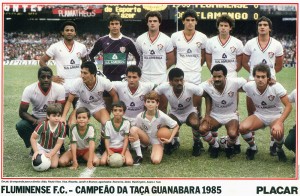
Fluinense (Rio de Janeiro)

Gremio (Porto Alegre)
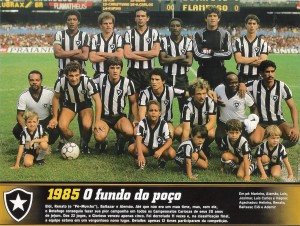
Botafogo (Rio de Janeiro)
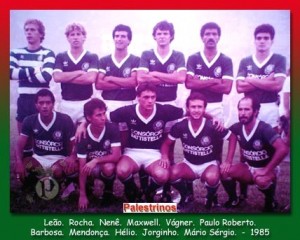
Palmeiras (Sao Paulo)
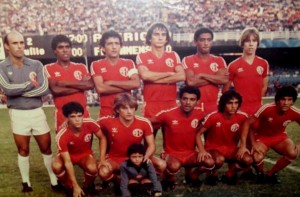
America (Rio de Janeiro). Standing from left: Waldir Peres, Beto, Teco, Pagani,Serginho, Denys. First row: Renato,Cléo, Moreno, Gaúcho, Ademir.

Santa Cruz (Recife)
Eliminated from Group B:
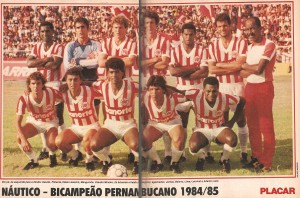
Nautico (Belem)

Santos (Santos)
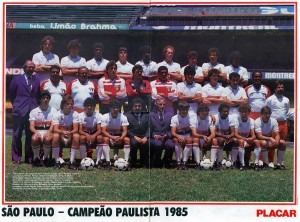
Sao Paulo (Sao Paulo)
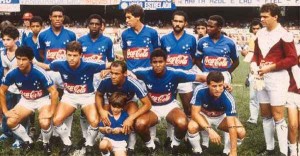
Cruzeiro (Belo Horizonte)
Goias (Goiania)

Portuguesa (Sao Paulo)
It is interesting to take a second look at the eliminated squads after the end of the season and compare them with the winners. And perhaps think why the early eliminated did not go ahead and stuck here.
First phase
Group C
Table – First stage
1-Sport 11 9 1 1 19- 3 19 Qualified
2-Mixto 11 5 4 2 12-10 14
3-Botafogo-PB 11 4 6 1 9- 7 14
4-CSA 11 5 3 3 16-11 13
5-Ceará 11 4 5 2 14- 8 13
6-Paysandu 11 3 6 2 11- 8 12
7-Nacional 11 4 1 6 15-18 9
8-Flamengo-PI 11 3 3 5 7-10 9
9-ABC 11 3 3 5 10-15 9
10-Sampaio Corrêa 11 1 6 4 12-16 8
11-Sergipe 11 2 2 7 6-17 6
12-Remo 11 1 4 6 10-18 6
Table – Second stage
1-Sport 11 9 1 1 23- 7 19 *
2-Ceará 11 9 0 2 20- 9 18 Qualified
3-Nacional 11 6 3 2 24-11 15
4-CSA 11 5 3 3 16- 8 13
5-Paysandu 11 5 3 3 15-13 13
6-Mixto 11 5 3 3 11-12 13
7-Botafogo-PB 11 3 4 4 12-16 10
8-Remo 11 4 0 7 9-20 8
9-ABC 11 3 2 6 17-18 8
10-Flamengo-PI 11 2 2 7 7-14 6
11-Sergipe 11 1 3 7 9-20 5
12-Sampaio Corrêa 11 1 2 8 12-27 4
* – Since Sport had already won the first stage, Ceará qualified as second stage runners-up
Table – Combined first and second stages
1-Sport 22 18 2 2 42-10 38 Qualified (1st and 2nd stage winners)
2-Ceará 22 13 5 4 34-17 31 Qualified (2nd stage runner-up)
3-Mixto 22 10 7 5 23-22 27 Qualified (overall record)
4-CSA 22 10 6 6 32-19 26 Qualified (overall record)
5-Paysandu 22 8 9 5 26-21 25
6-Nacional 22 10 4 8 39-29 24
7-Botafogo-PB 22 7 10 5 21-23 24
8-ABC 22 6 5 11 27-33 17
9-Flamengo-PI 22 5 5 12 14-24 15
10-Remo 22 5 4 13 19-38 14
11-Sampaio Corrêa 22 2 8 12 24-43 12
12-Sergipe 22 3 5 14 15-37 11
First phase
Group D
Table – First stage
1-Bangu 11 7 3 1 15- 6 17 Qualified
2-Ponte Preta 11 7 3 1 15- 6 17
3-Joinville 11 7 1 3 16- 6 15
4-Leônico 11 5 2 4 14-15 12
5-Pinheiros 11 4 4 3 13-10 12
6-Brasil (Pel.) 11 4 3 4 16-16 11
7-Brasília 11 4 3 4 12-12 11
8-Desportiva 11 4 0 7 12-17 8
9-Villa Nova-MG 11 3 2 6 10-15 8
10-Uberlândia 11 2 4 5 11-14 8
11-Vila Nova-GO 11 2 4 5 11-17 8
12-Corumbaense 11 1 3 7 4-15 5
Note: Bangu won the tie-breaking draw to determine 1st place
Table – second stage
1-Bangu 11 7 2 2 22-10 16 *
2-Brasil (Pel.) 11 6 4 1 20- 9 16 Qualified
3-Ponte Preta 11 5 5 1 22-12 15
4-Vila Nova-GO 11 5 2 4 14-17 12
5-Joinville 11 4 4 3 12-10 12
6-Brasília 11 4 4 3 10-10 12
7-Pinheiros 11 3 5 3 8- 7 11
8-Uberlândia 11 4 1 6 15-12 9
9-Desportiva 11 3 3 5 6-13 9
10-Corumbaense 11 3 2 6 12-22 8
11-Villa Nova-MG 11 2 3 6 8-16 7
12-Leônico 11 2 1 8 7-18 5
* – Since Bangu had already won the first stage, Brasil qualified as second stage runners-up
Table – Combined first and second stages
1-Bangu 22 14 5 3 37-16 33 Qualified (1st and 2nd stage winners)
2-Ponte Preta 22 12 8 2 37-18 32 Qualified (overall record)
3-Joinville 22 11 5 6 28-16 27 Qualified (overall record)
4-Brasil 22 10 7 5 36-25 27 Qualified (2nd stage runner-up)
5-Brasília 22 8 7 7 22-22 23
6-Pinheiros 22 7 9 6 21-17 23
7-Vila Nova-GO 22 7 6 9 25-34 20
8-Leônico 22 7 3 12 21-33 17
9-Desportiva 22 7 3 12 18-30 17
10-Uberlândia 22 6 5 11 26-26 17
11-Villa Nova-MG 22 5 5 12 18-31 15
12-Corumbaense 22 4 5 13 16-37 13
Eliminated from Group C:
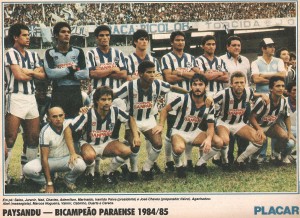
Paysandu (Belem – PA)
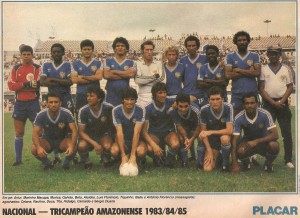
Nacional (Manaus – AM)
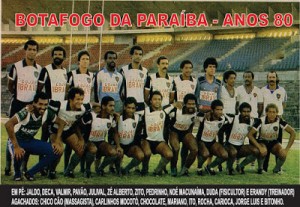
Botafogo (Joao Pessoa – PB)
ABC (Natal – RN)
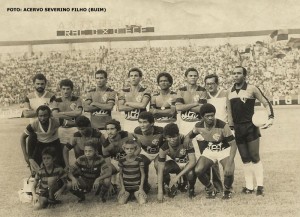
Flamengo (Teresina – PI)
Remo (Belem – PA)
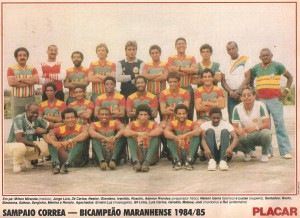
Sampaio Correa (San Luis – MA)
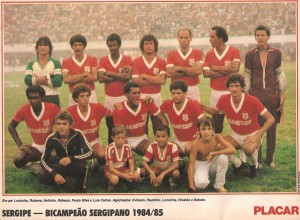
Sergipe (Aracaju – SE)
Eliminated from Group D:
Brasilia (Brasilia – DF)
Pinheiros (Curitiba – PR)
Vila Nova (Goiania – GO)
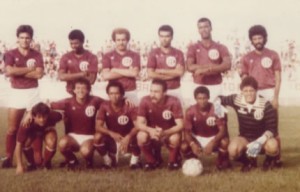
Leonico (Salvador – BA)
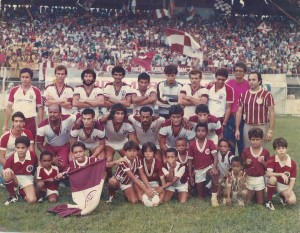
Desportiva (Cariacica – ES)
Uberlandia (Uberlandia – MG)
Villa Nova (Nova Lima – MG)
Corumbaense (Corumba – MS)
